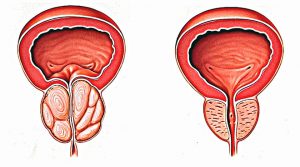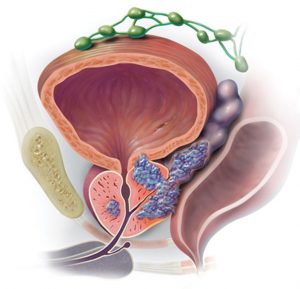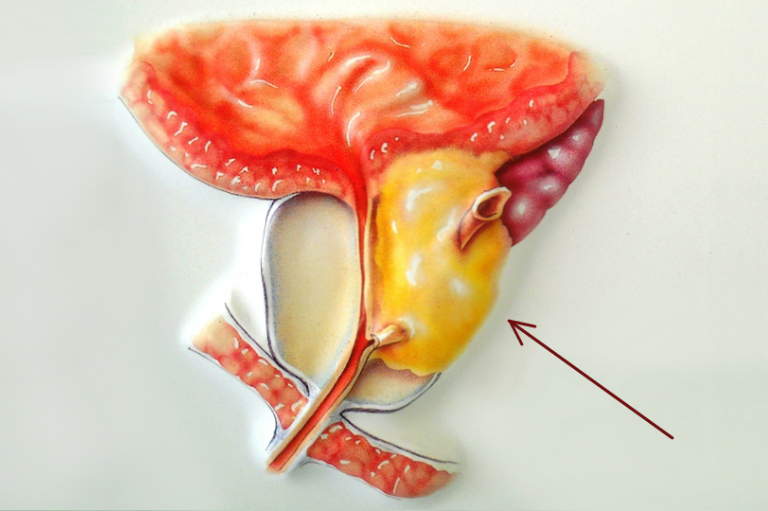Adenoma, or hyperplasia, of the prostate gland is an enlargement of the gland in size. From the period of male puberty, the prostate gland secretes a secret that is part of the sperm. The cells of the prostate gland under the influence of the male hormone testosterone divide, they become larger, and the gland increases in size.
We can say that prostate adenoma is a man’s payback for the qualities that testosterone endows him with: physical strength and masculinity. The prostate gland (prostate) is located along the urethra, so when it increases, it becomes difficult to urinate. Urine stagnates in the bladder. This causes infections and stone formation.
When and with whom can it appear?
Every man will sooner or later face the problem of enlargement of the prostate gland. On average, prostate adenoma symptoms appear after age 50. The risk that a man of this age will develop prostate adenoma is even in the absence of complaints. Early examination and early treatment will help to avoid serious consequences and operations on the prostate gland.
How do I know if I have a prostate gland?
The enlargement of the prostate gland interferes with the process of urination. Going to the toilet becomes a real torment: a sluggish stream requires more time and effort. Even after several minutes of trying, it seems that the bladder is full, a new urge appears. If many men put up with difficulty urinating and a sluggish stream, then frequent nighttime urges (more than 2-3 times a night) interfere with normal life.
What tests do I need to go through first?
Treatment regimens for prostate adenoma differ depending on the volume of the gland, the age of the man, and the level of prostate-specific antigen (PSA), which is only found in the prostate gland in the body. Determination of the PSA level is used to diagnose prostate cancer, and it is the results of this examination that the doctor will first of all take into account.
In addition, when examining a man, a urologist must collect information about the volume of the prostate gland. An experienced physician is able to determine an enlarged prostate by probing it with a finger through the rectum.
The exact volume of the gland and the volume of residual urine are measured by ultrasound. The volume of the gland is more than 30 cubic meters. cm is considered an increase. The residual urine rate should be no more than 50 ml.
Before visiting a urologist, a man over 40 must have a PSA blood test. If a man did not take this test, the urologist prescribes it and explains how to properly prepare for donating blood for PSA. After receiving the result, the man comes for a second consultation. The urologist analyzes the information received and recommends treatment or additional examination.
Why is it important to understand the meaning of PSA?
Prostate-specific antigen is used in the diagnosis of prostate cancer. The normal PSA level is up to 4.0 ng / ml, but its increase does not always mean that a man has prostate cancer. Having data on PSA, ultrasound and a man’s age, the urologist individually assesses the risk of prostate cancer and decides on further tactics.
There are cases of an increase in PSA with improper preparation for donating blood or inflammation in the prostate gland. In this case, re-delivery of the analysis is required after proper preparation and treatment.
Before donating blood for PSA, you should not go to the sauna and take a hot bath for 7 days, also sexual abstinence is recommended for a week, you should not undergo a digital examination of the prostate gland.
PSA is often monitored over time, that is, a man is tested every six months. If there is an increase in PSA, the man is additionally examined to exclude prostate cancer.
What will help me now?
You can use drugs to slow down the enlargement of the prostate. But pills help only at the initial stage of the disease. At an advanced stage, drugs work only temporarily or are completely ineffective.
For the treatment of prostatic hyperplasia, drugs from the group are most often prescribed: alpha-blockers and 5-alpha-reductase blockers.
Alpha-blockers relax the smooth muscle of the urethra and relieve the symptoms of adenoma. They do not affect the growth of the prostate gland. Basically, alpha-blockers are used to temporarily improve urination while preparing a patient for surgery.
5-alpha-reductase inhibitors slow down the growth of the prostate gland. Taking these drugs eliminates the stimulating effect of testosterone on the prostate gland. Treatment with 5-alpha reductase inhibitors makes sense to slow prostate growth in the future.
Drugs from both groups must be taken for a long time. Drug therapy for prostatic hyperplasia has side effects that limit its use.
How can prostate adenoma be cured?
Despite the possibilities of drug therapy, most men resort to surgical treatment. Previously, prostate adenoma was removed by an open route. Modern endoscopic methods of treatment allow a man to get rid of adenoma without a single incision.
Adenoma of almost any size is removed through the urethra – transurethrally with electrosurgical or laser instruments. This can be transurethral electroresection (TUR), or transurethral enucleation or vaporization.
The choice of an operative technique depends on the volume of the prostate gland.
During transurethral resection, the prostate gland is crushed with electrosurgical instruments and the fragments are washed out through the working channel of the endoscope. During vaporization, the tissue of the gland is crushed with a laser and washed out with a liquid. The accuracy of laser vaporization is higher than TUR, however, the operation itself takes longer.
Enucleation of the prostate gland involves the removal of the adenoma https://en.wikipedia.org/wiki/Adenoma in large parts. When combining the techniques and carrying out vapoenucleation, the prostate adenoma is removed entirely. Even with large prostate volumes, this technology can shorten the hospital stay. Removing the gland in a single block reduces blood loss during surgery. Immediately after surgery, urine is excreted through a urethral catheter, but the latest technology can reduce this time to just 2 days, after which the catheter can be removed.
What complications can there be?
As with any surgery, complications can develop after prostate surgery. These include bleeding, allergic reactions or inflammation. However, during the operation by experienced surgeons, they develop infrequently – only in 1-2%. In the same case, if complications do arise, the patient will have to stay in the hospital for several days.
